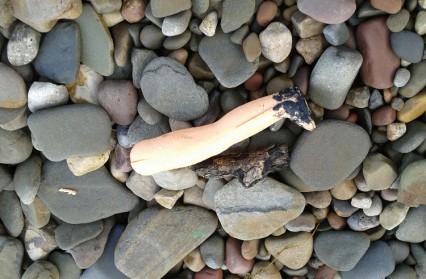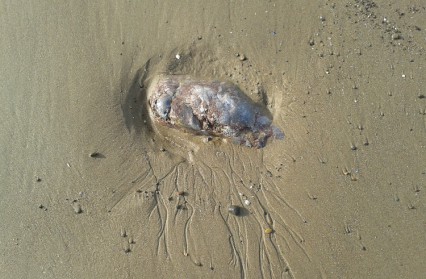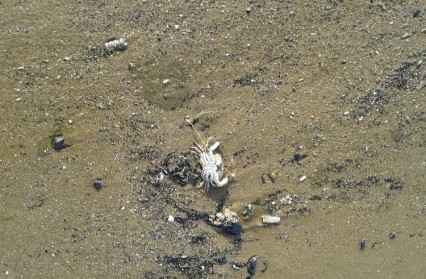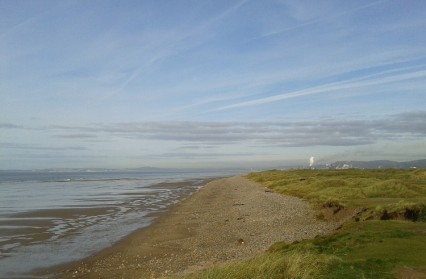At Kenfig Nature Reserve worlds meet and meld, and, in that place of melding, species clash and ecosystems flourish, often against the odds. Stretches of mobile sand dunes – home to the extremely rare fen orchid – are in a perpetual turf war with encroaching wild grasslands; Kenfig pool, which is an oasis for migrating waterfowl, lies barely a chip shot away from a manicured golf course. Perhaps the most graphic evidence of this struggle for life along the borderlines can be seen at Sker beach when the tide is low and the frontier between sandy shoreline and the grey expanse of the Bristol Channel is stretched thinnest, giving up all kinds of secrets.
After clambering down the crumbling ridge that leads from the dunes to the beach, the first things to catch my eye are the manmade objects spat out by the sea and strewn among stones in the high intertidal zone: a tangle of orange fishing net, a darkly rusted piece of ironwork, the plastic leg of a doll.
No matter how often I see this sort of debris littering a beach, it always jars me with its incongruity. In that sense, these forlorn objects do an exemplary job of representing their creator: that most incongruous of beasts, always standing out in terms of his inventiveness, innovation and capacity for disruption.
Wherever you walk in Kenfig you cannot help being aware that just a few miles down the coast looms the Port Talbot Steelworks. Five million tonnes of steel slab are produced here each year, at a rate of about 400 food cans per second. Its dark chimneys send up fumes and water vapour which accumulate in a thick, grey wedge. You can try not looking in the direction of the steelworks, but you never forget it’s there – as out-of-place as a doll’s leg on a beach.
Heading towards the shoreline, the stones peter out, revealing cool, moist sand. This is patterned with shallow pools left by the withdrawing tide, which reflect the clear October morning’s sky in periwinkle blue. There are pretty wrinkles in the sand where pebbles and shells have been dragged across it by the waves.
As I walk, I feel the waves pulling at me too – from a hundred metres away – beckoning to some primordial part of my being that craves re-immersion. Perhaps it is this sense of homecoming that one sometimes gets by the sea which E.E. Cummings refers to in the last stanza of his poem, ‘maggie and milly and molly and may’:
For whatever we lose (like a you or a me)
it’s always ourselves we find in the sea
Although we may feel ourselves drawn to the sea’s edge and strangely comforted by it, this is far from being a place of peace. Soon, the scattered islets of water spread into one continuous sheen, salt-and-peppered with duck clams and common mussel shells picked conspicuously clean of their inhabitants. Within a stone’s throw of the sea I find inky Rorschach patterns of silt, which, upon closer inspection, reveal themselves to be scenes of carnage. The clams and mussels were merely the hors d’oeuvre: this is where the real banquet has taken place. There are fragments of crabs tossed about – a pincer here, a carapace over there – segments of lugworms and smithereens of razor shells. It looks like the aftermath of a ruthless ambush; the kind in which no prisoners were taken. Splats of droppings give away the identity of the perpetrators: zealous beaks have been at work here.
For now, however, the birds have had their fill. The gulls are wheeling overhead, hectoring the world with their screeches. A parcel of oystercatchers is asleep further along the beach, each with its blood-orange bill tucked beneath its wings, as if concealing the murder weapon.
Standing at the shoreline and scanning the beach I see a young woman daubing rocks with pink paint. At first I think she has chosen an unlikely spot for graffiti bombing, but as I get nearer I notice she has a bucket and a couple of notebooks beside her. I stroll up to ask what she’s doing and she’s happy to stop and explain. She is Rose Massingham, a Zoology student at Cardiff University, currently on a placement year at Kenfig. Her task is to study honeycomb worms. In particular, she is investigating how healthy they are by taking core samples of their reefs. Rose tells me that the paint marks are to help her remember which reefs she wants to come back to and take samples from.
Honeycomb worms build their reefs onto rocks, using sand and minute shell fragments to create hundreds of densely collocated tubes in a pattern resembling a honeycomb. Once a colony is established it attracts worm larvae, which up until that moment spend their lives adrift in seawater. These then add their own tubes as they grow into adulthood, ensuring that the colony continues to expand. The reefs are vulnerable however, Rose explains, to cold weather and storm damage, as well as to human factors such as pollution and trampling feet. I thank Rose for her time and let her get back to work. Then, taking care not to tread on any reefs, I start back toward the dunes.
The bladderwrack and sea lettuce I glimpse growing in the rock pools reminds me that seaweed is the coastal boundary dweller par excellence. From clinging to cliff faces barely within the spray area, to being anchored to the seabed thirty metres beneath the surface, seaweed thrives in all niches of the littoral zone. It has existed for over a billion years and every land plant on Earth evolved from it. I believe that this is the miracle of evolution that Rabindranath Tagore celebrates:
I find this cheering. We homo sapiens like to congratulate ourselves on being one of the few animals capable of crossing boundaries with ease, able to move on earth, under water, even through the air. Yet humble seaweed, seldom looked at twice by the majority of seaside visitors, is the granddaddy of every plant on the planet. It has transcended its boundaries and is still going strong after so many years. I wonder if humankind will be able to say the same on its one-billionth birthday.
Benjamin Palmer was born and grew up in Cardiff but lived for many years in Barcelona, working as a teacher, translator, actor and musician. In 2012 he returned to Wales to study for an MA in Creative Writing at the University of Swansea. He is currently residing in Guadalajara, Mexico. His poetry has appeared in the New Welsh Review and the Wales Arts Review. He blogs here: magnificentmammothballet.blogspot.com and you can find him on Twitter here:














